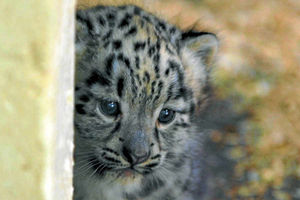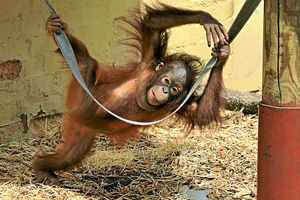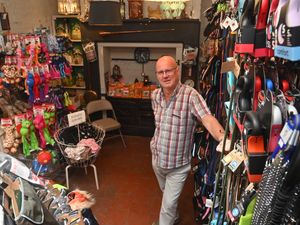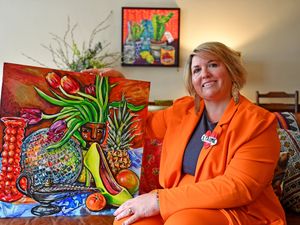You can't beat that first look at a little fluff ball snow leopard
Zookeeper Laura Robbins loves her job at Dudley Zoo but never more than in the middle of a baby boom, writes Elizabeth Joyce.

What do you get a tapir for Christmas? "Oh, that's easy," says Laura Robbins. "They love melons, pineapples and coconuts – they're the perfect gift.
"Christmas Day is the only day of the year the zoo is closed but all the keepers still come in to give our animals presents. They get sprouts too."

Senior keeper Laura has worked at Dudley Zoo since she was 16 – and visited the site every Saturday before then for eight years, such was her love for animals.
But she has never known a busier time than now because, as well as undergoing a £3 million redevelopment, the zoo is in the middle of a baby boom.
Eight barbary sheep, seven reindeers, three capybaras and a host of meerkats and wallabies have all been born recently. But it is a nine-week-old snow leopard that has everyone talking.
The as-yet unnamed cub is the first to be born at the 76-year-old zoo in 12 years.
And, after cosying up behind closed doors with its mum – three-year-old Nanga – since its birth on May 2, the little one is now out and about and the star attraction.
"Everyones going crazy for the new baby," says 24-year-old Laura. "Nanga is a first-time mum and you just don't know what to expect, especially with the cats, but she has done perfectly. Nanga is very protective of the cub but also quite relaxed and let's it roam about and explore.
"We won't know the sex of the cub until we microchip it at 12 weeks and that's also when it will get to meet its dad, two-year-old Margaash.
"This has been the most exciting birth we've had for years. There is a lot of interest.
"We had a camera in the den so we could keep an eye on Nanga and make sure she was OK while she was pregnant.
"When one of your animals is expecting, it is a very stressful time for a keeper. You're always thinking about it and sit there with your cup of tea at home at night wondering, Hmm, has it happened yet?. The animals always give birth at night because in the wild that's typically the safest time for them to do so. You'll always come into work that little bit earlier if one of your animals is expecting.
"You go through all the stages with them. You see them change physically and you see their personalities change. It's our job to keep them safe and well but also to give them some privacy and respect. When an animal is born, we make sure both it and its mother have some space."
And what does Laura make of the newest arrival?
"The first time I saw the leopard cub, it was just a little grey fluff ball. When it was a week-and-a-half old we got to go in and make sure it was OK. I had a very quick look then and it was amazing. You can't beat that first look at something as amazing as a snow leopard."
Laura, who hails from Rowley Regis, is one of 70 rangers at the zoo who look after more than 1,300 animals covering 170 species.
But is life as a zoo keeper really the dream career so many people expect it to be?
"Quite simply, yes it is," says the former Heathfield High School pupil, who loves her job so much, she even visits the zoo on her days off with friends and family.
"I always thought it was a dream job, a job that happened to other people, but after starting off as a season ticket holder, adopter and then volunteer, I became a trainee keeper on my 16th birthday and haven't looked back since.

"I love animals, always have. I have cats, dogs and geckos at home and would take one of the tapirs if they'd let me."
However, this is a career not for the faint hearted.
"It's definitely not all glitz and glamour behind the scenes," laughs Laura, who looks after the big cats and hoofed stock. "I'm usually covered in mud, fur and goodness knows what else. I'm always in muddy wellies and my uniforms get washed more times than I care to remember.
"There's no such thing as a typical day for a zookeeper. There's a bit of a routine in the morning: you clean them out, you prepare the food, you check on their health but otherwise it's a bit of everything. You could be painting an enclosure, giving a talk to school kids or chasing a tapir around for two hours."
Speaking of which, the tapirs share their home with the capybaras, the worlds largest rodent, and there are three new arrivals here.
Mum Peanut is now a mother to 10 after the three females were born 10 weeks ago.
"Cute, arent they?," beams Laura. "Fancy being a mum of 10. Peanut's really good though and we just let her get on with it.
"In fact, the only time we ever step in is if a mother rejects the baby. That mostly happens with the penguins. It's exhausting for the keepers if that happens because you have to take on the feeds and be in the bizarre situation of teaching a penguin how to be a penguin.
"Luckily though we have 70 penguins here so there are plenty of other birds around to help in that process. It's more difficult if, say, a lion rejects its cub and that did actually happen a few years ago with our lion Sam."

But one of the most popular babies on site didn't actually arrive in this latest boom, she popped out two years ago.
Sprout is a Bornean orang utan and was the first one to be born at Dudley since her own mother Jazz 20 years previously.
"Everyone loves her but poor little Sprout, she has a bad hair day every day. She has this wild orange hair that sticks up all the time," says Laura.
"She's progressing really well though. Last year, she was still really clingy to her mum but she's all over the place now and is getting much better at her rope skills."
But, just like the other animals, the orang utans are left to it when it comes to bringing up baby.
"We dont go in and handle them," explains Laura. "Orang utans are actually classed as dangerous as the lions and tigers because of not only their strength, but their intelligence too. They could basically rip you apart if they wanted to.
"But even so, they're not actually classed as the most dangerous animals on site – that's the giraffes. A single kick from a giraffe can kill a lion so we have to be really careful when we're around them. People are always surprised at that."
But there are plenty of things that go on behind the scenes that would surprise people.
For example, each and every animal on site has its own tag or microchip, allowing the keepers to identify it and then check up on it's computerised records, which include things like if it's ever been picked on, any personality traits to be aware of and its eating habits.
So, while they may have 70 penguins – all indistinguishable to the untrained eye – the keepers know each and every one individually down to the smallest of details.

"Oh yeah, we know things like which reindeer doesn't like carrots or which one is a bit of a bully. It may sound trivial but information like that could be vital if the animal moves on somewhere else for breeding or has a specific issue that needs addressing.
"We also have stud books, which are basically like Bibles for breeding. We hold the stud book for the black lemurs and it contains information on each one in different zoos around the world. The detail is incredible."
So, aside from the huge transformation of the site itself, what's next for Dudley Zoo? Excitingly, the answer is tiger babies.
Dudley is home to Daseep, who, as well as having his own online weekly blog, is one of the most important Sumatran tigers in the world when it comes to breeding and conservation. Staff are hopeful that tiger cubs will soon be joining the zoo's ever-growing family.
"It's a wonderful place to work," concludes Laura. "I feel so lucky each and every day and when there's lots of new arrivals, it's even more exciting than usual. Who else gets to see snow leopards or giraffes on a daily basis?
"I may finish up every day covered in mud but I couldn't be happier."





